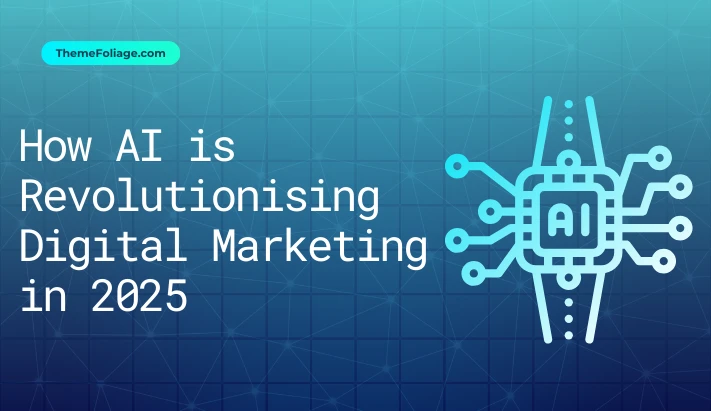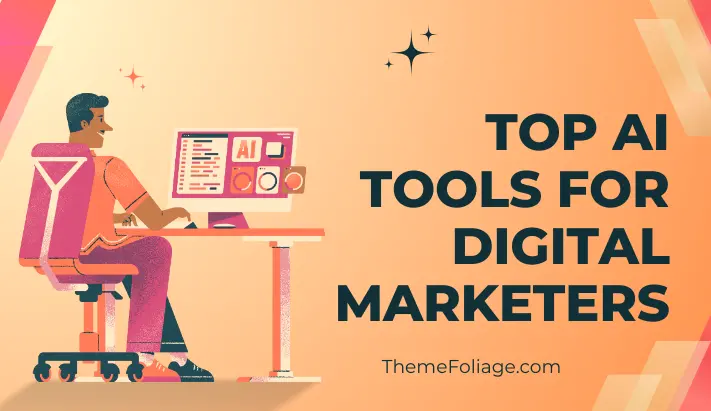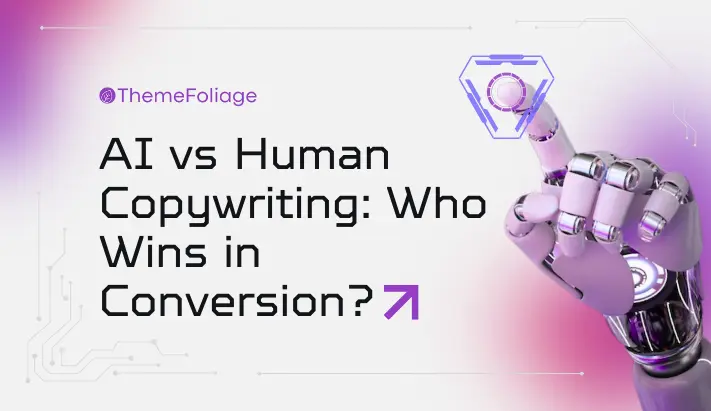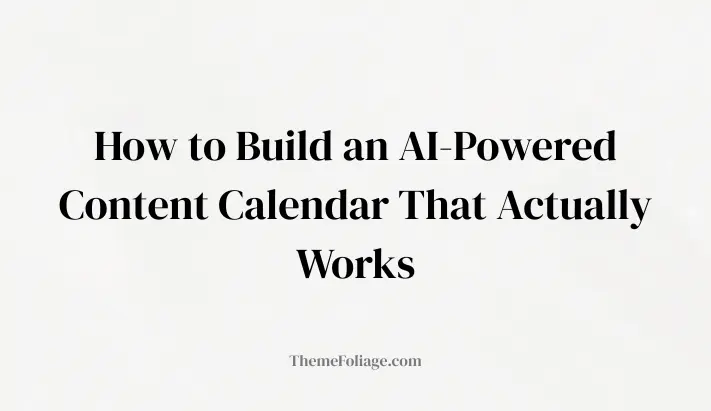The digital marketing landscape has undergone a profound transformation by 2025, with artificial intelligence evolving from an emerging technology to the fundamental backbone of marketing operations worldwide.
AI has fundamentally changed how marketers approach strategy, execution, and optimization across all digital channels. According to industry reports, agencies utilizing AI for marketing operations have reported up to a 30% increase in ROI and significant reductions in time spent on repetitive tasks.
This comprehensive analysis examines the multifaceted ways AI is reshaping digital marketing, from SEO and PPC to content creation and social media management, while addressing the critical ethical considerations and implementation challenges that marketers face in this new era.
1. The New AI-Powered Marketing Paradigm
The integration of artificial intelligence into digital marketing represents more than just technological adoption, it signifies a complete paradigm shift in how businesses connect with consumers.
Unlike traditional marketing approaches that relied heavily on intuition and historical data, AI-powered marketing operates on predictive analytics, real-time optimization, and hyper-personalization at unprecedented scales.
This transformation has made AI not just valuable but essential for competitive relevance; as noted by industry experts, “If you’re still thinking of AI as experimental, you’re already behind”.
Marketing departments that have fully embraced AI operate within a continuous optimization loop where campaigns automatically adapt to consumer behavior, content dynamically adjusts to individual preferences, and budget allocation constantly rebalances toward the highest-performing channels.
This represents a move from periodic campaign-based marketing to an always-on, intelligently adaptive approach that responds to market signals in real-time.
The most successful organizations have stopped treating AI as a standalone tool and instead built entire marketing ecosystems around AI-driven systems .
2. AI-Driven SEO Transformation
2.1: Beyond Keyword Stuffing: Intelligent Optimization
Search engine optimization has evolved dramatically beyond manual keyword research and placement strategies. By 2025, AI tools analyze countless ranking factors simultaneously to provide actionable recommendations that align with increasingly sophisticated search algorithms.
Tools like Surfer SEO, Clearscope, and SEMrush’s AI-powered features now provide real-time content grading that evaluates not just keyword density but semantic relevance, readability, topical authority, and E-E-A-T (Experience, Expertise, Authoritativeness, Trustworthiness) signals that have become critical ranking factors .
The most advanced AI SEO platforms now offer predictive performance analysis, allowing marketers to simulate how content might perform before publication. These tools cross-reference content against top-performing competitors, identify semantic gaps, and recommend structural improvements that significantly increase the likelihood of ranking success.
For example, Writesonic’s AI SEO agent can pull insights from multiple data sources including Google Search Console, SEMrush, and Ahrefs to provide specific, actionable tips to improve existing content .
2.2: AI and the E-E-A-T Challenge
As AI-generated content becomes more prevalent, search engines have placed greater emphasis on E-E-A-T principles to ensure quality and reliability in search results. This has created both a challenge and opportunity for marketers.
The most successful SEO strategies now use AI for optimization while maintaining strong human oversight for content expertise and authoritative perspective .
Forward-thinking marketers are leveraging AI to enhance rather than replace human expertise by using these tools to:
- Identify content gaps in their existing portfolios
- Optimize for semantic relevance rather than just keywords
- Structure information for better user experience and comprehension
- Monitor performance across both traditional and AI-powered search interfaces
Table: Key AI SEO Tools and Their Capabilities
| Tool Name | Primary Function | Unique Capability |
|---|---|---|
| SEMrush | All-in-one SEO platform | Tracks brand visibility in AI search results |
| Writesonic | Content creation & optimization | Real-time SEO data integration |
| Clearscope | Content optimization | Real-time relevance scoring |
| Ahrefs AI Content Helper | Search intent optimization | Integrated with Ahrefs’ extensive database |
| Rankscale.ai | AI search tracking | Tracks visibility across AI engines |
3. Revolutionizing PPC with AI Automation
3.1: Intelligent Bidding and Budget Optimization
Pay-per-click advertising has been transformed by AI’s ability to process vast datasets and make micro-second adjustments that maximize ROI.
Platforms like Google Ads Smart Bidding and specialized tools like AdAlchemy.ai now use machine learning algorithms to forecast which users are most likely to convert, ensuring ad spend is allocated with unprecedented efficiency.
These systems analyze historical performance data, user behavior patterns, contextual signals, and even external factors like time of day or day of week to optimize bid strategies in real-time.
Case studies demonstrate the dramatic impact of AI-driven PPC management. One travel company reported a 20% reduction in cost-per-click while maintaining top ad positions after implementing AI-powered real-time bidding.
Similarly, e-commerce brands have seen 25% increases in click-through rates through AI-generated dynamic ads that tailor creative elements to individual user preferences .
3.2: Hyper-Targeted Audience Segmentation
AI has revolutionized audience targeting by identifying micro-segments that would be impossible to detect through manual analysis.
By processing first-party data alongside broader market signals, AI algorithms can identify patterns and predict user behavior with remarkable accuracy. This enables marketers to move beyond basic demographic targeting to behavioral and contextual targeting that reaches users based on their real-time intent and engagement patterns .
The integration of AI with first-party data has become particularly crucial as privacy regulations increase. AI systems can now create effective targeting strategies while maintaining compliance with regulations like GDPR and CCPA.
For example, a financial services firm reported a 15% improvement in lead quality after integrating first-party data with their AI-driven PPC campaigns .
4. Email Marketing Personalization at Scale
4.1: Beyond Basic Segmentation: Predictive Personalization
Email marketing has evolved from basic segmentation to AI-driven predictive personalization that anticipates individual subscriber needs and preferences.
Modern AI email tools analyze each subscriber’s engagement history, content preferences, purchase behavior, and even browsing patterns to create uniquely tailored messaging strategies for every individual on a list.
The most advanced systems now employ behavioral triggers that automatically send emails based on specific user actions or inactions.
For example, if a user abandons a cart or spends time viewing a particular product category, AI systems can trigger a series of increasingly personalized emails designed to re-engage that specific user with content most likely to resonate with their demonstrated interests.
4.2: Optimized Send-Time Engineering
Gone are the days of batch-and-blast email scheduling. AI algorithms now determine the optimal send time for each individual subscriber based on their historical engagement patterns.
These systems continuously test and refine send times to maximize open and click-through rates, resulting in dramatic improvements in engagement metrics.
Industry reports indicate that brands using AI-driven send-time optimization have seen email engagement rates increase by as much as 30% compared to traditional methods .
Additionally, AI tools now dynamically personalize subject lines, preview text, and even content blocks within emails based on individual recipient profiles.
This means two subscribers receiving the same campaign might see entirely different subject lines and content arrangements optimized for their specific engagement history and preferences.
5 Social Media Management Revolution
5.1 Predictive Analytics and Optimal Timing
Social media management has been transformed by AI’s ability to analyze engagement patterns and predict optimal posting times for maximum visibility.
AI-powered platforms like Lately.ai and Ocoya analyze historical performance data, audience activity patterns, and content characteristics to determine the precise times when each piece of content is most likely to resonate with its intended audience .
Beyond scheduling, AI tools now provide content recommendations based on trending topics, audience interests, and performance predictions.
These systems can analyze thousands of successful posts across platforms to identify patterns and formulas that drive engagement, then recommend content strategies that align with these proven approaches.
5.2 Automated Content Repurposing and Generation
One of the most valuable applications of AI in social media management is automated content repurposing.
AI tools can now automatically transform long-form content like blog posts or whitepapers into multiple social media formats including carousels, short-form videos, quote graphics, and thread posts.
This dramatically increases content efficiency while maintaining consistent messaging across platforms.
Advanced AI systems also generate platform-specific adaptations of content, optimizing messaging for the unique conventions and audience expectations of each social network.
The same core message might be transformed into a professional LinkedIn article, an entertaining TikTok video, and a visually-focused Instagram post, all with minimal human intervention required.
6. AI-Driven Content Creation Ecosystem
6.1: From Idea Generation to Execution
Content creation has been revolutionized by AI’s ability to assist at every stage of the development process. AI tools now support idea generation, outline creation, draft development, and optimization dramatically reducing the time and resources required to produce high-quality content.
Tools like Jasper.ai, Writesonic, and Copy.ai have become sophisticated enough to generate coherent, contextually appropriate content that requires less human editing than earlier generations of AI writing tools.
The most effective content teams now use AI as a collaborative partner rather than a replacement for human creators.
As one expert notes, “AI can optimize. But it can’t imagine. The best campaigns still come from human insight, emotion, and bold thinking”.
This collaborative approach leverages AI for efficiency while maintaining human oversight for strategy, creativity, and brand voice consistency.
6.2: Multiformat Content Adaptation
Beyond text generation, AI tools now create and adapt content across multiple formats including video, audio, and visual media.
Tools like Synthesia enable marketers to create AI-generated videos with human-presenter avatars, while image generation tools like Google’s Imagen 3 model allow for the creation of customized lifestyle visuals for advertising campaigns.
This multiformat capability is particularly valuable for maintaining consistent messaging across channels while adapting content to each platform’s unique requirements.
A single core message can be transformed into a blog post, video script, social media posts, email newsletter, and advertising copy—all with minimal manual effort required for adaptation.
Table: AI Content Creation Tools and Applications
| Tool Category | Representative Tools | Primary Applications |
|---|---|---|
| AI Writing Assistants | Jasper, Writesonic, Copy.ai | Blog posts, social content, product descriptions |
| SEO Content Tools | Surfer SEO, Clearscope, Koala AI | Content optimization, keyword strategy |
| Video Creation Tools | Synthesia, Pictory | Explainer videos, social video content |
| Multichannel Platforms | HubSpot, Copilot | Cross-platform content adaptation |
7. Ethical Considerations and Implementation Challenges
7.1: Privacy and Transparency Imperatives
As AI becomes more embedded in marketing operations, ethical considerations have moved to the forefront of implementation strategies. Consumers increasingly demand transparency about how their data is being used and expect brands to use AI responsibly.
Regulations like GDPR and CCPA have established legal frameworks for data privacy, but leading brands are going beyond compliance to establish ethical AI guidelines that build trust with increasingly conscious consumers.
The most successful implementations of AI in marketing prioritize what industry experts call “privacy-first personalization“—an approach that delivers highly relevant experiences while maintaining transparent and ethical data practices.
This includes clear communication about data usage, easy opt-out mechanisms, and deliberate limitation of data collection to what is necessary for delivering value.
7.2: Balancing Automation and Human Connection
A critical challenge in AI-driven marketing is avoiding over-automation that makes brands feel robotic or impersonal.
As noted in the search results, “Yes, AI can automate workflows, optimise targeting, and even write content. But lean too hard on it, and your brand starts to feel robotic”.
The most effective marketing strategies maintain careful balance between automated efficiency and human authenticity.
This balance requires maintaining human oversight of AI systems, particularly for customer-facing communications. Strategies include:
- Establishing clear brand voice guidelines that AI tools must follow
- Maintaining human review processes for sensitive or high-value communications
- Using AI for initial drafting and optimization while preserving human creativity for strategic direction and final refinement
8. The Future of AI in Marketing
8.1: Emerging Trends and Developments
As AI continues to evolve, several emerging trends are poised to further transform digital marketing. These include:
- AI-powered virtual influencers: Advanced AI personalities that can engage in meaningful, real-time interactions with audiences
- Dynamic content adaptation: Content that transforms based on viewer behavior, time of day, or global events
- Voice and visual search optimization: As voice assistants and image recognition technologies improve, optimizing for these platforms will become increasingly important
- Predictive customer journey mapping: AI that can anticipate individual customer paths and pre-emptively address needs and objections
8.2: Implementation Recommendations
For marketers looking to maximize AI’s potential in 2025, the search results suggest several best practices:
- Start with specific use cases rather than attempting organization-wide implementation simultaneously
- Invest in training to ensure teams can effectively leverage AI tools
- Maintain strategic oversight to ensure AI aligns with business goals and brand identity
- Prioritize data quality since AI outputs depend heavily on input data accuracy and completeness
- Balance automation with authenticity to maintain brand voice and human connection
Conclusion: The AI-Powered Marketing Future Is Now
Artificial intelligence has fundamentally transformed digital marketing from an art informed by science to a science enhanced by art. By 2025, AI has become the indispensable backbone of marketing operations, enabling unprecedented levels of personalization, efficiency, and effectiveness.
The marketers thriving in this new landscape are those who have successfully integrated AI into their strategies while maintaining the human creativity, emotional intelligence, and ethical judgment that technology cannot replicate.
The revolution is not without its challenges ethical considerations, implementation complexities, and the need for continuous learning present ongoing hurdles.
However, the benefits far outweigh the difficulties for organizations that approach AI adoption thoughtfully and strategically. As the search results emphasize, “AI isn’t replacing agencies. It’s giving them a serious upgrade, if they know how to use it”.
The future belongs to marketers who can harness AI’s power while maintaining the human touch that ultimately builds brand loyalty and drives long-term growth.



